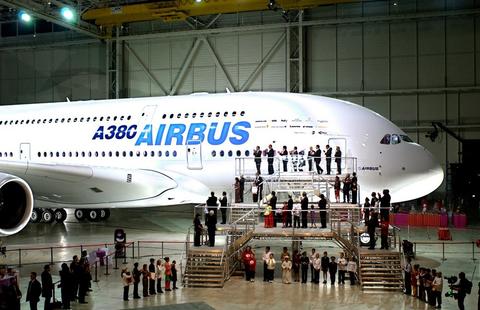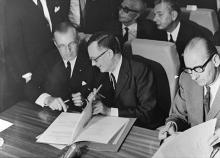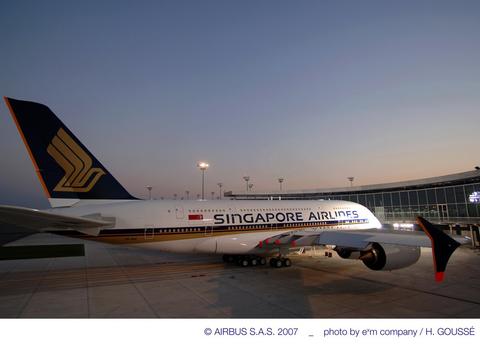On 7 May, 2004, before more than 3,000 guests, the French Prime Minister Jean-Pierre Raffarin officially opened the A380 final assembly line in Toulouse.
The size of the site itself was impressive enough – the main assembly hall was one of the largest buildings of its kind, measuring 490 metres by 250 metres with a height of 46 metres and, with other buildings on the site, comprised 32,000 tonnes of steel (the equivalent of four Eiffel Towers).
But the impact of the occasion was even more so. Now the pioneering spirit of Airbus which had inspired the company’s success from the very earliest days and through all its programmes and technological innovations had risen again in the A380. It was more than a new aircraft capable of carrying 525 people in two classes 8,000 nm/15,000 km - or non-stop from Europe to Asia, North America and South America.
Production of major components for the first A380s, which would be used for ground and flight tests to achieve certification, were well-advanced – the airframe to be used for structural tests was revealed in its assembly jigs at the A380 Final Assembly Line opening ceremony. Using its innovative know-how Airbus had devised a new system to transport the wings, fuselage sections and horizontal tailplane on a specially-built ferry, then by barge and road to Toulouse from its manufacturing sites in France, Germany, Spain and Britain.
As the year moved on, the first complete A380 to be assembled came off the production line and was painted in readiness for its unveiling to the world.

A380: “A new way of flying”
The A380 Reveal on 18 January, 2005, created publicity around the world and won plaudits for its imaginative style. The national leaders of Britain, France, Spain and Germany joined more than 5,000 guests – including customers, suppliers and hundreds of journalists – to witness the unveiling of the aircraft Airbus said would usher in “a new way of flying”. The aircraft was painted in a new Airbus livery. By now there were 14 launch customers and 149 orders for the A380 and its freighter version, the A380F. The spectacular Reveal ceremony, held in the A380 Final Assembly Facility, featured fireworks, dry ice, lasers, dancers, and projected images of all of Airbus’ aircraft flying around the hall, while a narrator in the form of a hologram wizard spoke of the magic of aviation and how the dream of the A380 had become a reality thanks to the vision and spirit of Airbus. The event was streamed live to hundreds of thousands of people through the airbus.com website – which recorded a record number of visitors - and a number of television channels broadcast it live. (On the following day some 5,000 Airbus employees enjoyed their own special replica Reveal ceremony, which was broadcast live to employees at Airbus sites around the world.)
Following the Reveal, anticipation built towards the A380’s first flight, which took place in Toulouse on 27 April, 2005, in front of the world’s media. On a brilliant spring day the A380 – with the registration F-WWOW and powered by four Rolls-Royce Trent 900 engines – took off for a flight lasting three hours and 54 minutes, jointly captained by Claude Lelaie, Senior Vice President Flight Division, and Jacques Rosay, Chief Test Pilot and Vice President. Other crew members on this historic flight were Fernando Alonso, Vice President Flight Division, flight test engineers Jacky Joye and Manfred Birnfeld, and test flight engineer Gérard Desbois. The flight could not have gone more perfectly. Afterwards Rosay said flying the biggest passenger aircraft the world had seen was “like handling a bicycle”. And Lelaie enthused: “We now really sense the potential of this magnificent machine.”

2005, a year to remember
With a substantial number of firm orders, the A380’s economy and environmental superiority – along with its technological innovations and use of weight-saving composites confirms Airbus’ position as one of the world’s leading aircraft manufacturers. As passenger traffic is expected to triple over the coming 20 years, the A380 will help ease the pressures faced by its customers for airport slots by carrying more people per flight.
But other significant events also made 2005 a year to remember for Airbus. In July came the 2500th delivery of an A320 Family aircraft – an A320 to China Eastern Airlines. The Airbus Corporate Jetliner, based on the A319, enjoyed its most successful year to date by winning 11 new orders and increasing the number of customers to 25 (by end of August). The wide-body programme continued to win new orders for its highly-popular A300-600 freighters. And as Airbus strengthened its global foothold, a new engineering centre was set up in China to join others in Wichita (set up in 2002), and a joint venture in Russia (2003), and a second U.S. engineering centre in Mobile, Alabama (in 2007).




